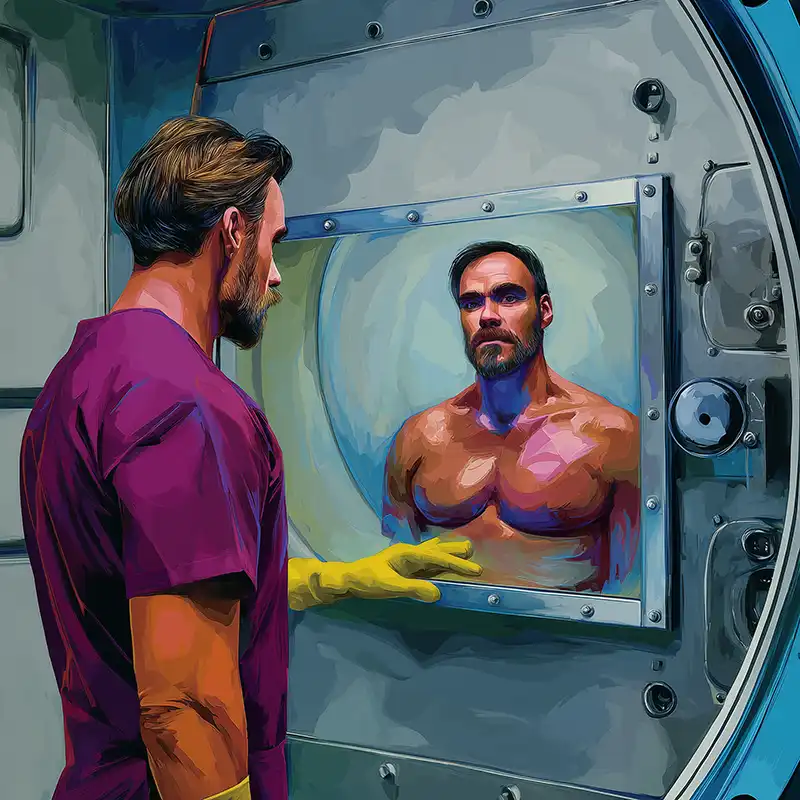The Many Arms of Doctor Verrick
The Discovery
The meters bounced and the devices whirred as Dr. Kevin Verrick stood beneath the glare of daylight overhead fluorescents. His arms crossed as he watched the mysterious figure pacing behind the structurally reinforced glass wall. Identical in body height/weight, frame and facial features the man was a mirror image of himself down to every molecular detail, save for one slightly disturbing deviation. The visage of an apparent third arm extended from the left side of the clone's torso, just below the original Homo Sapien shoulder. It twitched and flexed in time with the other arms, as natural as breathing. It was still glistening slightly with the synthetic amniotic fluid in which it had developed.

Subject V9, Verrick's ninth and most successful full human clone was extremely calm, almost too calm. "Do you feel any pain?" Verrick asked, a tinny voice that echoed through the laboratory intercom. V9 stopped pacing and looked up in an air of imaginative contemplation. His face, Verrick's own complete likeness wore a calm and serene expression. "Only when you sleep, I dream what you won't let yourself remember." He had built V9 from the ground up, every cell, every neural pathway, ever bio system replicated. The dream patterns were meant to be symbolic placeholders, construct archetypes, not actual memories. But V9 wasn't just extrapolating, he was remembering.
Verrick opened his private notes and entered a new directive: *Initiate full neuro-mapping comparison between Source (self) and Subject V9. Investigate signs of possible engram leakage.*
He hesitated, then added: *Determine whether Subject V9 can access autobiographical memory fragments not explicitly encoded in the general subconscious framework.*
If that was true, if V9's brain was somehow reconstructing Verrick's lived experiences... Then he was more than just a clone. He was a continuation and Verrick didn't know how he felt about gaining that unintentional attribute. The Clonal Optimization Initiative, launched under the aegis of the Global Biomedical Accord, had one simple goal: create human clones optimized for dangerous, repetitive, or complex tasks where standard robotic automation fell short. With enhanced musculature, stamina, and in V9's case, modular limb generation, clones could serve in zero-gravity repair, deep-sea recovery, or even military applications with higher efficiency.
The breakthrough had come quite unexpectedly. Stem-morphogens, when paired with Verrick’s own neuromorphic scaffolding, allowed tissues to grow contextually, responding to both genetic instructions and environmental stimuli. Initially, the idea was to regenerate human limbs. A missing arm, perhaps, replaced as a substitute. But V9 had grown an additional one, deliberately. That was quite the tactical and moral problem!
"He's not obeying lock-down protocols," murmured Dr. Camile Bogota, Verrick's assistant and the project's lead ethicist. She held her tablet close, tapping it nervously.
That evening, Verrick sat alone in the observation room, watching V9 in sleep state. Three arms tucked beneath him like some reposed Shiva. In his mind, he heard the words again: “No more than you feel when you dream of running.” What did a clone dream of? The neurologic mapping said V9 had default cognitive functions: perception, problem-solving, language. But personality traits were not part of the original codebase. Was it fabricating one on its own?
Verrick watched the recorded footage again and again. No hesitation, and no conflict between unique tasks. A note scrawled in the clone's notebook caught his eye: "Why was I made as one, if I am becoming many?" He stared at the utterance of the sentence. It was poetic, certainly almost pretentious. But it struck him with the weight of a looming prophecy.
Next Page >